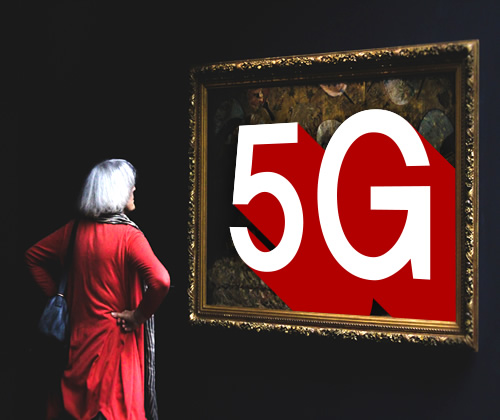5 Ways 5G Could Impact Museums

Every day, another major news headline comes out citing the transformative power of 5G. According to the World Economic Forum, “we’re on the verge of a new age of interconnectedness” that will change the world in profound ways. This isn’t just an incremental improvement to existing 4G network technology, it’s an entirely new mobile infrastructure. Now, after years of speculation about the potentials of 5G, it’s finally here.
The expansion of 5G networks promises to revolutionize a range of industries. But, how will it affect museums around the globe? Already, 5G is making its mark on the museum world. Just a few months ago, the Palace Museum in Beijing launched a plan to incorporate 5G technology into its 720,000-square-meter compound. The Forbidden City Museum, one of the most visited museums in the world, is in the vanguard of the 5G revolution, and now serves as a model for the ways museums can harness the increased connectivity of 5G and the Internet of Things (IoT) to unleash their unrealized potential.
In this post, we’ll explore 5 ways the 5G revolution will reshape museums.
1. Facilitate Frictionless AR & VR Experience
One of the greatest benefits of 5G is its low latency, reliability, and ultra-high speeds. This low latency unlocks new potential applications for augmented and virtual reality in museums. No longer will you be limited by bandwidth or geography. According to Forbes, “A reliable 5G network will help VR and AR applications evolve to the next level. Some even say the future of immersive is reliant on 5G.” With the rapid growth of VR and AR in museums, 5G will enable better, frictionless, and more reliable experiences to be delivered to visitors. It will also enable the most ambitious of projects that would have otherwise been impossible due to large file size and connectivity challenges.
[High Tech Storytelling: Museums, Exhibits, and AV]
2. Enable Innovative Ways to Preserve and Store Collections
The upkeep and preservation of museum collections can be a strenuous job and often requires specialized knowledge. What if the one expert you need for a particular artwork is across the world? 5G can solve that. The State Hermitage Museum in St. Petersburg, Russia, one of the largest art museums in the world, has implemented a 5G trial network with amazing results. 5G offers a high speed and low latency. This means that with the help of a robotic arm, art masters with rare expertise can conduct restoration work with a high degree of accuracy from anywhere in the world.
A daily selection of features, industry news, and analysis for AV/IT professionals. Sign up below.
3. Connected IoT Framework
According to a survey by Ericksson, “92% of executives from 100 major telecom operators, globally, agree that 5G will pave the way for new emerging technologies.” and one of the major areas of innovation and growth would revolve around IoT. With 5G comes the possibility of realizing the potential of new and improved type of IoT framework within museums. What exactly does this mean? There are four components of IoT: the “Things” themselves, a network, the Internet, and back-end services. The end goal is to build an interconnected system and 5G enables the most IoT friendly ecosystem to date. Installing IoT infrastructure within museums could involve networked sensors, smart lighting and frames, fully contextual digital signage, and new types of experiences layered on top of the new network.
[AI Powers New "Dali Lives Exhibit" at Dali Museum]
4. Tap Into More Data-Driven Insights
5G also enables museums to collect new kinds of demographic information. In the past, museums have relied on bare-bones statistics about the annual number of visitors and the annual revenue to evaluate their performance and strategize to attract more visitors. But with IoT-connected cameras and sensors, museums will be able to track visitors’ journeys through the museum, just like Beijing’s Palace Museum has already begun.
By tapping into the 5G network, museums will be able to collect more nuanced information in real-time about the popularity of specific exhibits, spaces, and objects, in addition to demographic data about its visitors. New research on IoT application in museums illuminates just that: “IoT can be used to gather and analyze visitor generated data, leading to data-driven insights that can fuel novel, adaptive, and engaging museum experiences.” This will open up new possibilities for designing exhibitions, launching targeted marketing campaigns, and contextual content based on visitor interests.
5. Optimize Energy Efficiency
All around the world, museums are going green. MFA Boston’s Art of the Americas Wing has served as a template for environmental museum design.
The Water + Life Museums were the world’s first LEED Platinum certified museums in the United States, and lots of others have followed suit. The Field Museum and the Barnes Foundation are now also LEED Platinum certified, and the Museum of the American Revolution, the National Museum of African American History and Culture, and the Boston Children’s Museum are just a few of the museums that boast LEED Gold certification.
5G can usher in the era of museum environmentalism by offering new possibilities for energy management. Within a connected communication network, museums will be able to optimize their power consumption and ensure that network attached devices communicate in real-time and use energy efficiently.
We’re on the precipice of the 5G revolution, and museums won’t be left behind. Just as new technologies like artificial intelligence open a world of new potential, 5G offers new possibilities for museums to engage visitors in meaningful ways, so it’s time to start thinking creatively about how to harness the power of increased connectivity.
This blog was originally published at https://cuseum.com/blog/2019/7/8/5-ways-5g-could-impact-museums. It is republished with permission from Cuseum.

